Unhedged: We’re all bears on the dollar now

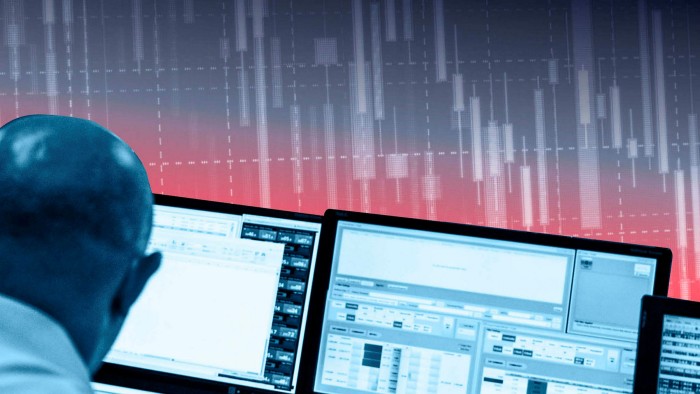
Roula Khalaf, Editor of the FT, selects her favourite stories in this weekly newsletter.
This article is an on-site version of our Unhedged newsletter. Sign up here to get the newsletter sent straight to your inbox every weekday
Welcome back, and welcome to the week where Unhedged tries not to talk about inflation. We’ll see if events allow that to happen. Today the topic is the dollar. Which has nothing to do with inflation. Nope. Not a thing.
Got a view on the greenback? Email it to me at robert.armstrong@ft.com
Whither (or is it wither?) the buck
It is hard to find a foreign exchange analyst or an investor on Wall Street who is not bearish on the dollar. That may be reason enough to expect the currency to rise, but let’s consider the bear case first. Most often, it is grounded in the US’s “twin deficits”.
First deficit: current account. The US buys a lot more stuff from the rest of the world than the world buys from the US. That difference has to be financed; as a matter of mathematical identity, there has to be an inflow to match that outflow. There could be inflows in the form of, for example, direct foreign investment in US real assets or, as is more often the case, investment in US securities, most often our sovereign bonds (we do make a lot of them, after all).
There is a limit to this, theoretically. At some point, the interest on all those bonds would consume the entire US budget. And that limit gets a little closer if the US also has a second deficit, in its budget, because it is spending loads of money on other stuff, like transfer payments, aircraft carriers, or whatever. Here are where the twin deficits stood as of 2020. They almost surely have gotten worse since (via the Fed):
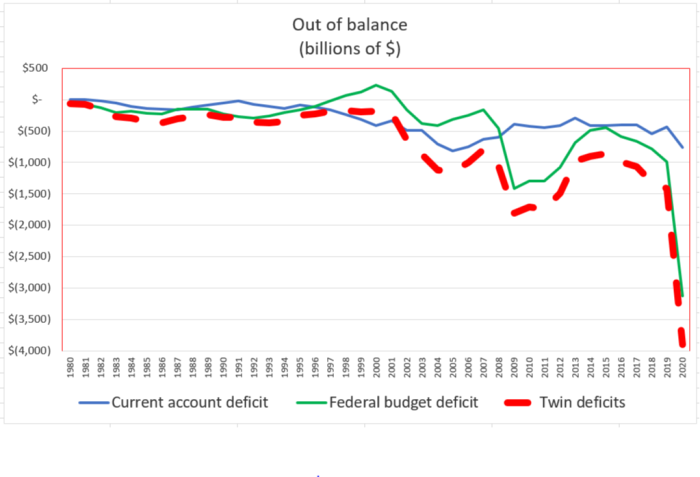
At some point, the buyers of all those bonds will look at a chart like this and demand higher interest payments. But let’s suppose (just suppose) that the US government is also intervening to keep the rates on its bonds low. What is going to fix the imbalance then?
The dollar can help: if it falls, everything in the US — its securities, its exportable goods, its companies — go on sale for the rest of the world. That draws assets in, keeping the accounts in balance. In a country where the books are wildly out of whack, the dollar can be the counterweight.
Don Rissmiller of Strategas summed up the point bluntly to me. When you have a major imbalance like the US has, “you have to get poorer, either locally or globally”. But, he cautions, none of this has to happen quickly. As a global reserve currency, and as a safe place in a crisis, the US currency remains “the cleanest dirty shirt,” among the global currencies. This was clear at the beginning of the pandemic, when the dollar rose with demand for safe assets. Here is the DXY dollar index:
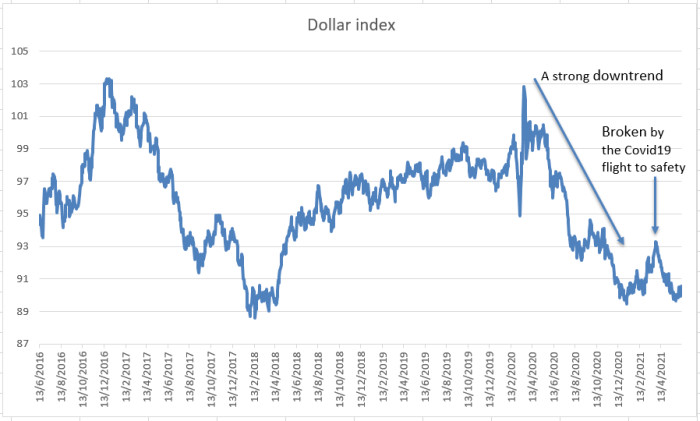
Rissmiller also points out that if the dollar is going to fall, it has to fall against something. But what? While the US is one of the world leaders in vaccinations and growth, he says, capital seems likely to keep flowing towards dollar assets. But this could change, he says, as the rest of the world catches up, and we might end up with 2017-style synchronised global growth, sending capital out towards the rest of the world for better returns.
Currency traders often talk about the “dollar smile”. This refers to the fact that the dollar rises at the two ends of the US growth spectrum. If the US is outgrowing the rest of the world, then the dollar rises as capital flows to America. If US growth is particularly sluggish, as it was in March of 2020, then that probably means the whole world is in poor shape, meaning that US assets become an attractive safe haven, driving the dollar up again. It is in the middle of the growth spectrum, where the US is fine, but not world-beating, that the dollar tends to weaken. Rissmiller is arguing, in essence, that we could be heading back to the middle of the smile.
Calvin Tse, a Citigroup FX analyst, is a long-term dollar bear, too, but not because of the twin deficits. He thinks the appeal of US Treasuries will endure. “What’s happened over the past decade, ever since the financial crisis, is a rip in equity prices, resulting in a big build-up in global wealth. Investors are very long risk, and they need safe assets in their portfolios to offset that.” In this excellent chart he shows how global savings and risk assets have shot up, but safe assets have not kept pace:
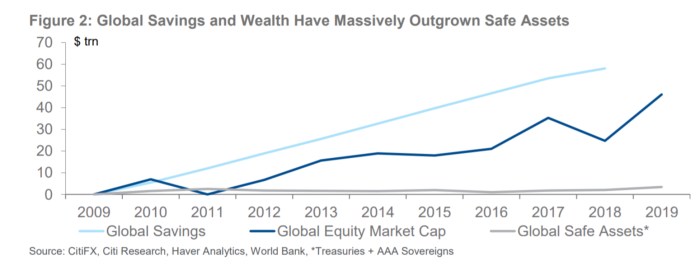
Furthermore, as the Japanese and German central banks have bought up more and more of their own sovereign bonds, US Treasuries have become an increasing slice of that proportionally smaller store of truly safe assets:
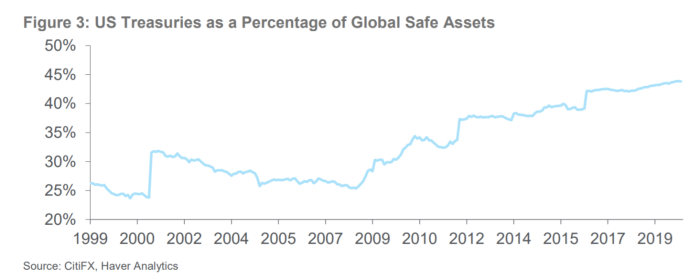
Tse sums up: “When risk sells off, as it did in March of 2020, nothing makes money but AAA sovereign assets, but there are not many AAA assets out there.” As a result, he expects “perpetual” high demand for Treasuries.
Like Rissmiller, he thinks what may ultimately weaken the dollar is a resurgence of global growth, but he thinks the model here is not 2017 but the early-to-mid-2000s. Back then global economic activity rose and, just like today, a long bull market in equities driven by US tech companies was receding into the rear-view mirror. Again, we’re looking at that low, middle bit of the dollar smile.
If the dollar is going to weaken, how should investors position themselves? The traditional answer is that stocks that report in US dollars, but generate a big chunk of their revenues abroad, should see their profits rise as the dollar falls. Tech companies are the classic choice. Commodities companies’ products are priced in dollars, so they too will see higher revenues if the dollar weakens. But in the case of tech stocks, currently trading at somewhat dizzying valuations, it is worth considering this chart from Rissmiller’s colleague at Strategas, Jason Trennert:
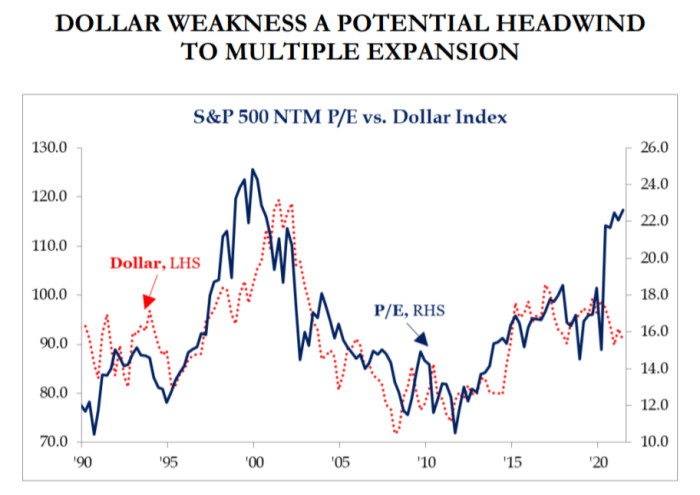
Price/earnings valuations tend to fall when the dollar weakens. This makes sense. If a coming period of global growth does, in fact, draw capital towards risks elsewhere in the world, what is going to happen to the prices of tech stocks, which have after all had a tremendous bull run?
One good read
The FT’s bard of bankruptcy, Sujeet Indap, has written the amazing story of Hertz’s bankruptcy. The company stock was left for dead by Wall Street, only to be revived by retail “meme stock” traders — who were proved right in the end. As Sujeet says, it is “the perfect metaphor for an upside-down year on Wall Street.”
Comments